2024 Moto Guzzi Stelvio
After celebrating the milestone of its 100th anniversary in 2021, Moto Guzzi unveiled the V100 Mandello in 2022, an innovative motorcycle conceived and designed completely from scratch to usher in a new era for Moto Guzzi complete with a new liquid-cooled 90° transverse V-twin engine.
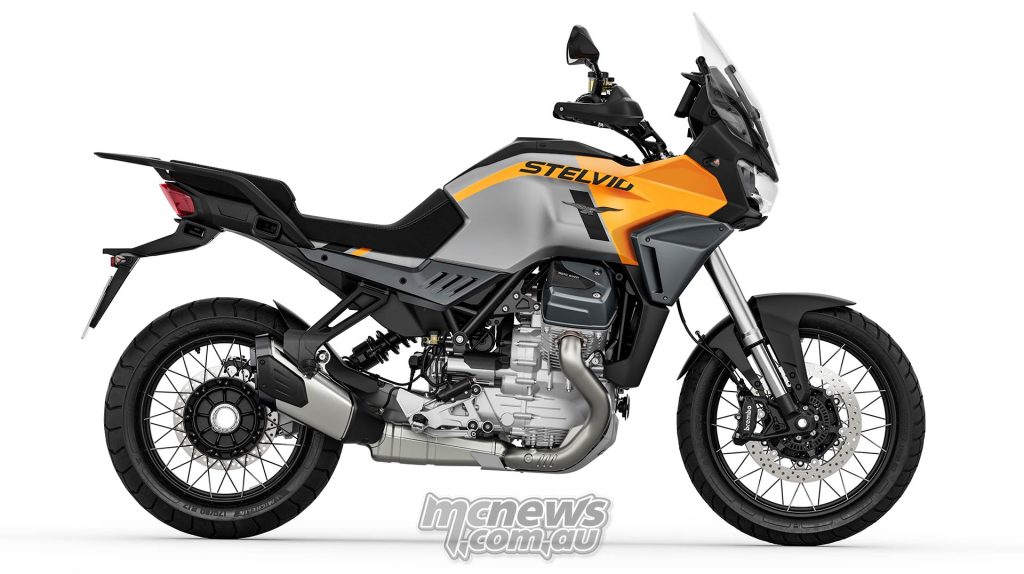
On the modern technical basis that is the V100 Mandello, Moto Guzzi now introduces the new Stelvio.
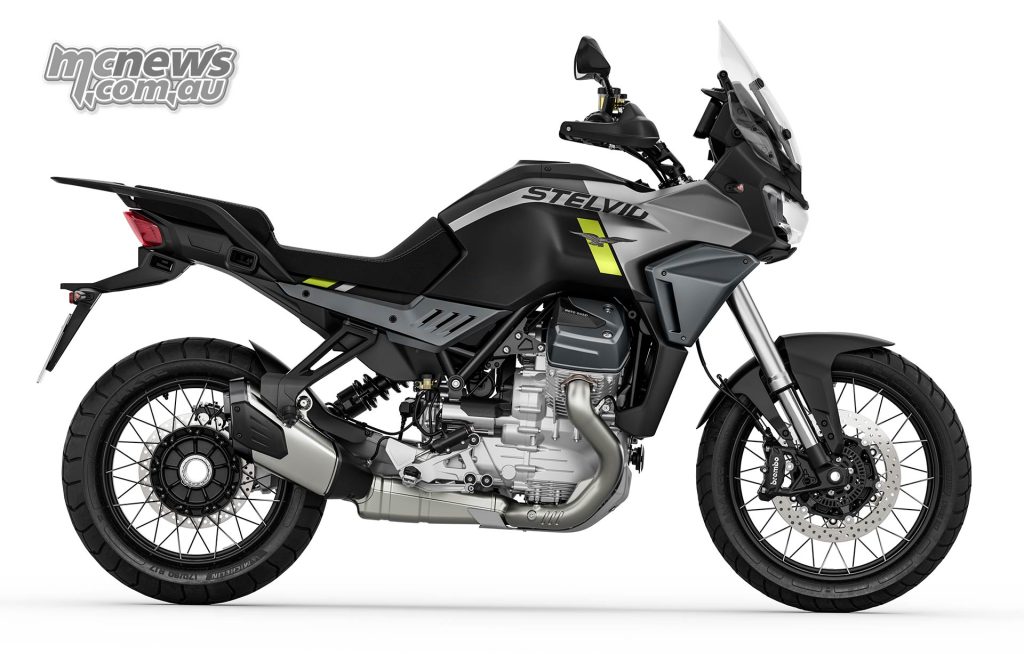
While there are numerous captivating twin-cylinder engines available in today’s motorcycle market, Moto Guzzi are the only ones that boast a 90° transverse V-twin configuration and that’s the hallmark of Moto Guzzi.
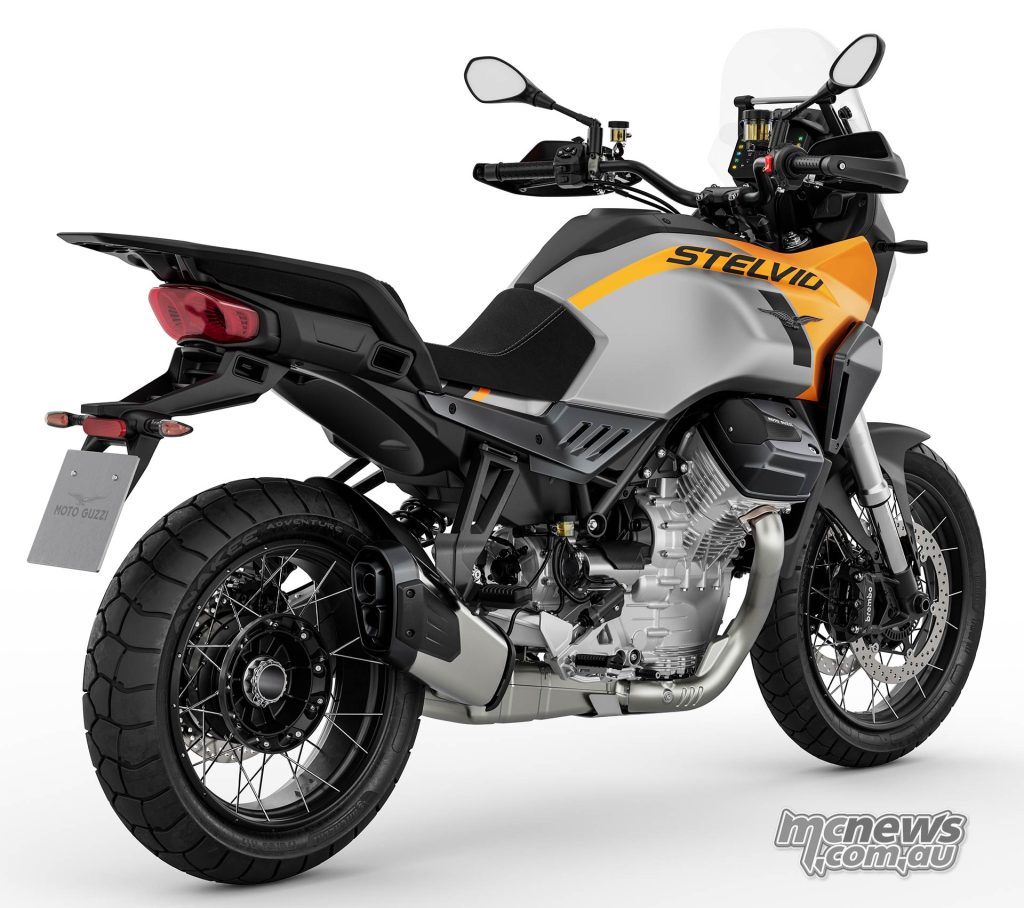
The V twin is not only the beating heart of the Stelvio, but also the epicentre of its design, just as it is on every other current Moto Guzzi. The entire design commences with the elevation of the sculptured engine, where the cylinders appear to burst out of the tank and progress in a contemporary style.
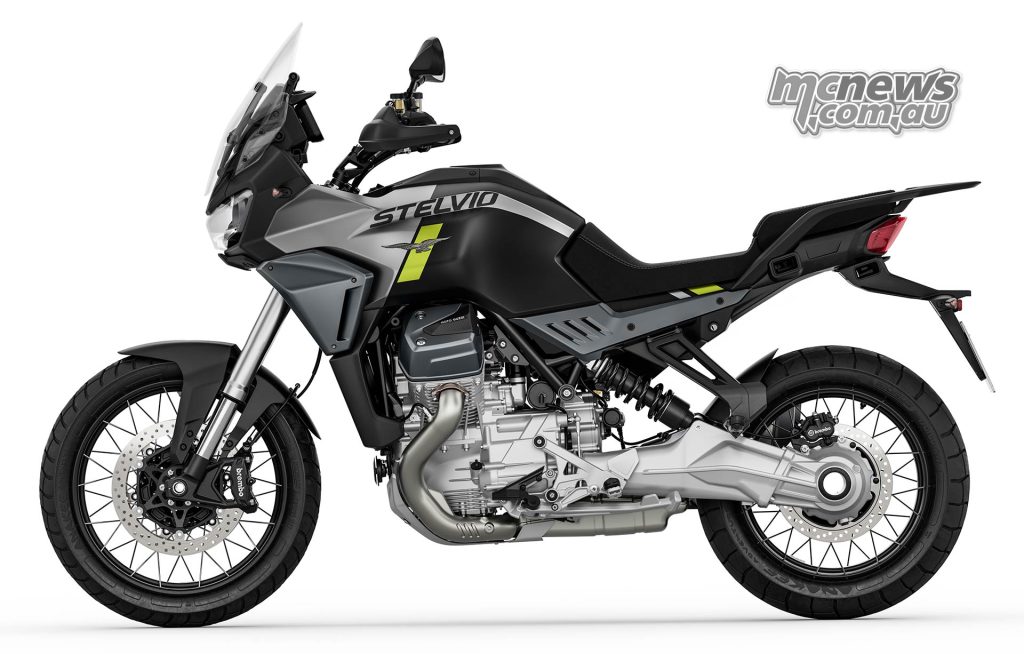
Aerodynamics have undergone an extensive and meticulous overhaul, spearheaded by a dedicated team of engineers solely focused on this aspect. The aim was to optimise air protection, comfort and the joy of riding, aligning with Moto Guzzi’s legacy as the first pioneering motorcycle brand to possess its very own wind tunnel. It took more than 1,500 hours of simulations with CFD (Computational Fluid Dynamics) calculation software and countless sessions in the wind tunnel to determine the ideal surfaces that would offer maximum protection for the rider and passenger, while occupying the least space.
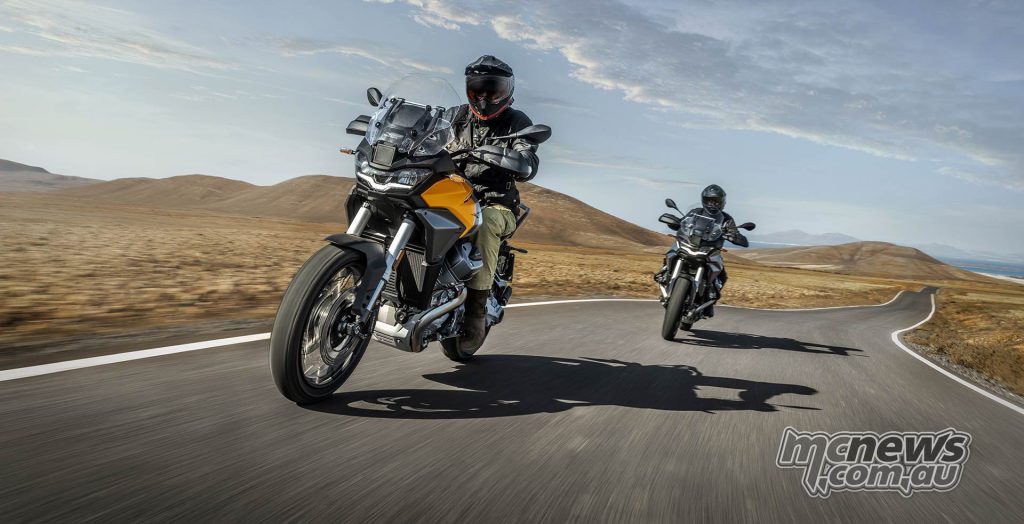
The windshield was also the subject of special study and is shaped to deflect flows while avoiding rear air vortices, aided by the presence of the two side deflectors. To accommodate different statures, it is electrically adjustable in height up to 150 km/h, with a range of as much as 70 mm.
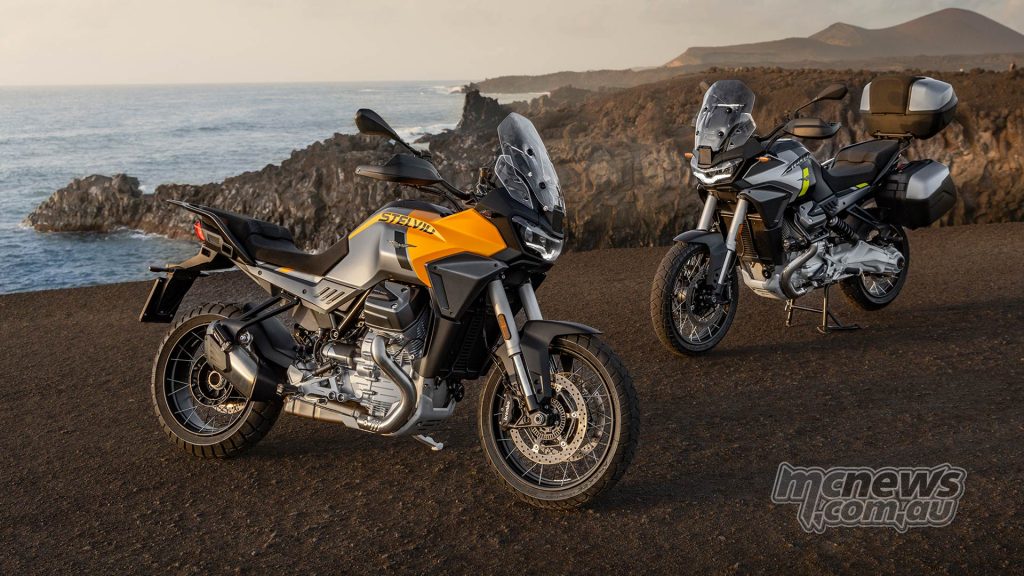
Whichever way you look at it, it is unmistakably a Moto Guzzi: the identity is confirmed frontally by the LED lighting system, with DRLs stressing the outline of the eagle, and laterally too, by the particular, unique architecture of its completely exposed engine. Meticulous attention to detail extends to this aspect: the radiator’s inconspicuous placement and the concealment of rubber connection hoses from view, alongside the thorough refinement of the electrical system, where the wiring remains completely hidden.
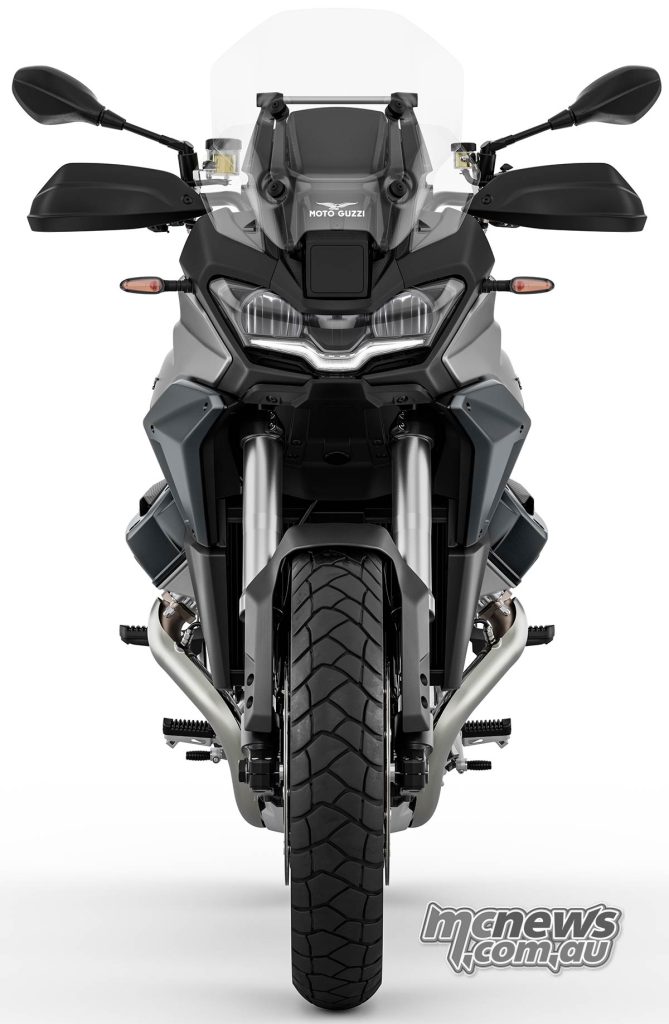
Moto Guzzi Stelvio is powered by the engine unit recently introduced on the V100 Mandello, a 90° transverse V-twin with liquid cooling and dual overhead camshaft timing with finger rockers and four valves per cylinder.
The effective displacement is 1042 cc, while the bore to stroke values are 96 x 72 mm. As mentioned, the crankcase takes advantage of wet sump lubrication, with the crank chamber separated from the oil sump by a reed valve pack. This system allows for a lower engine due to a shallower oil pan, saving space and lowering the volumes which benefits the handling and – in the case of the Stelvio – leaves ample ground clearance for avoiding off-road obstacles.
Maximum power is 115 hp at 8,700 rpm while maximum torque is 105 Nm at 6,750 rpm, with 82 percent available as early as 3,500 rpm. The limiter set at 9,500 rpm. Service intervals are scheduled every 12,000 km.
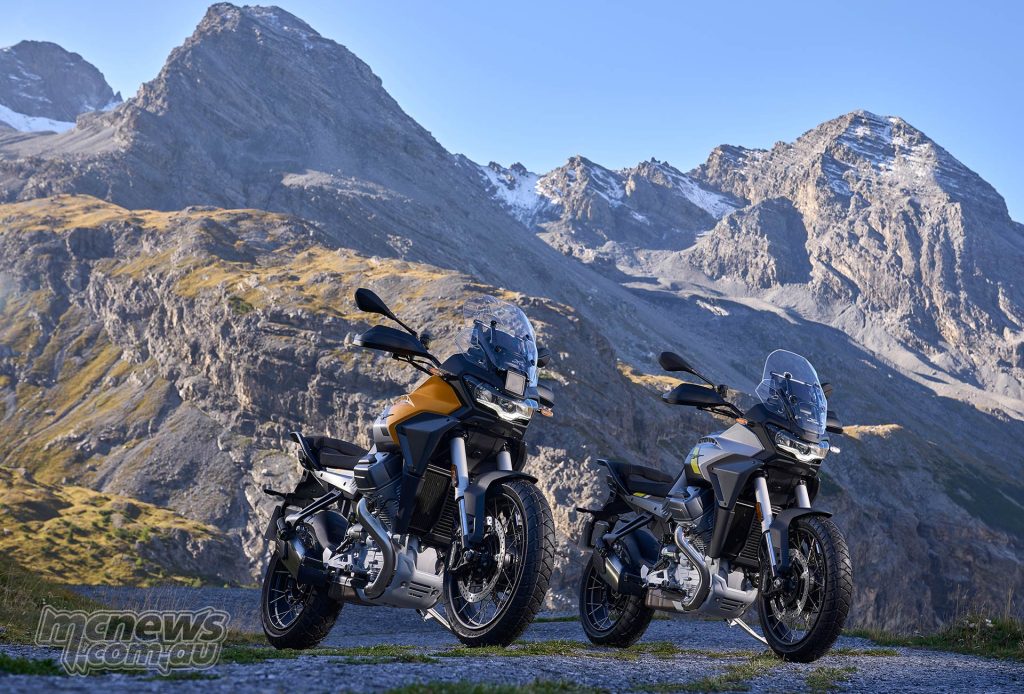
A huge effort has been made to decrease inertia as much as possible (up to 50 per cent less than the previous 1200 8V engine), decreasing weight and giving better responsiveness.
A counter-rotating shaft is integrated, designed not to balance the primary forces, as they are inherently balanced by the 90° architecture. Instead, its purpose is to reduce reverse torque, something that earlier Guzzi models were well renowned for, and not in a good way.
The ground-up design has yielded an exceptionally compact power unit, measuring 103 mm shorter than the smaller block of the V85 TT and weighing less than the 1200 8V, the last four-valve engine manufactured by Moto Guzzi. A significant contribution comes from the hydraulically controlled wet multi-plate clutch with a slipper system.
The headers are equipped with protective shields designed to divert hot air flows away from the rider’s legs.
The six-speed gearbox has undergone a redesign, resulting in even smoother and more seamless gear shifts. This was achieved by relocating the cotter from the primary shaft of the gearbox to the clutch, thereby enhancing its damping capacity and overall operation. The performance of the quick-shift system (available as an accessory) has been improved.
The final drive shaft drive makes use of an aluminium single-sided arm positioned on the left side. Compared to the one on the V100 Mandello, it has been reinforced to adapt it to off-road use. The minimal output of the drive shaft and the extensive longitudinal extension of the swingarm have effectively eradicated the initial upward effect upon opening the throttle, eliminating the necessity for reaction rods on the swingarm. A solitary universal joint located at the swingarm fulcrum features a bevel gear set at an 84° angle (in contrast to the 90° angle found on other Moto Guzzi models). This arrangement allows the swingarm to accommodate a 170/60 tyre fitted on a 4.5-inch tubeless spoke rim, emphasising the adventurous spirit of the Moto Guzzi Stelvio.
A 21-litre fuel tank that extends beneath the seat.
Compared to the front end found on the V100 Mandello, the Stelvio has undergone a complete redesign making it stronger and better suited for adventure riding. The frame also boasts four front anchor points instead of the two on V100 Mandello, giving a 20-percent increase in rigidity. Srelvio rolls on a 1520 mm wheelbase with a 25.6° steering head angle.
The touring attitude is guaranteed by the ample comfort of the generously sized seat, positioned at just 830 mm above the ground and the active riding position that keeps the back upright and the legs slightly bent. It is easy to manage from a standstill and offers solid balance when both feet are on the ground, thanks to its narrow central section.
The new Stelvio also features wide, adjustable-section aluminium handlebars while the passenger can count on a wide, well-padded portion of the seat with large grab bars and a posture that allows comfortable movement.
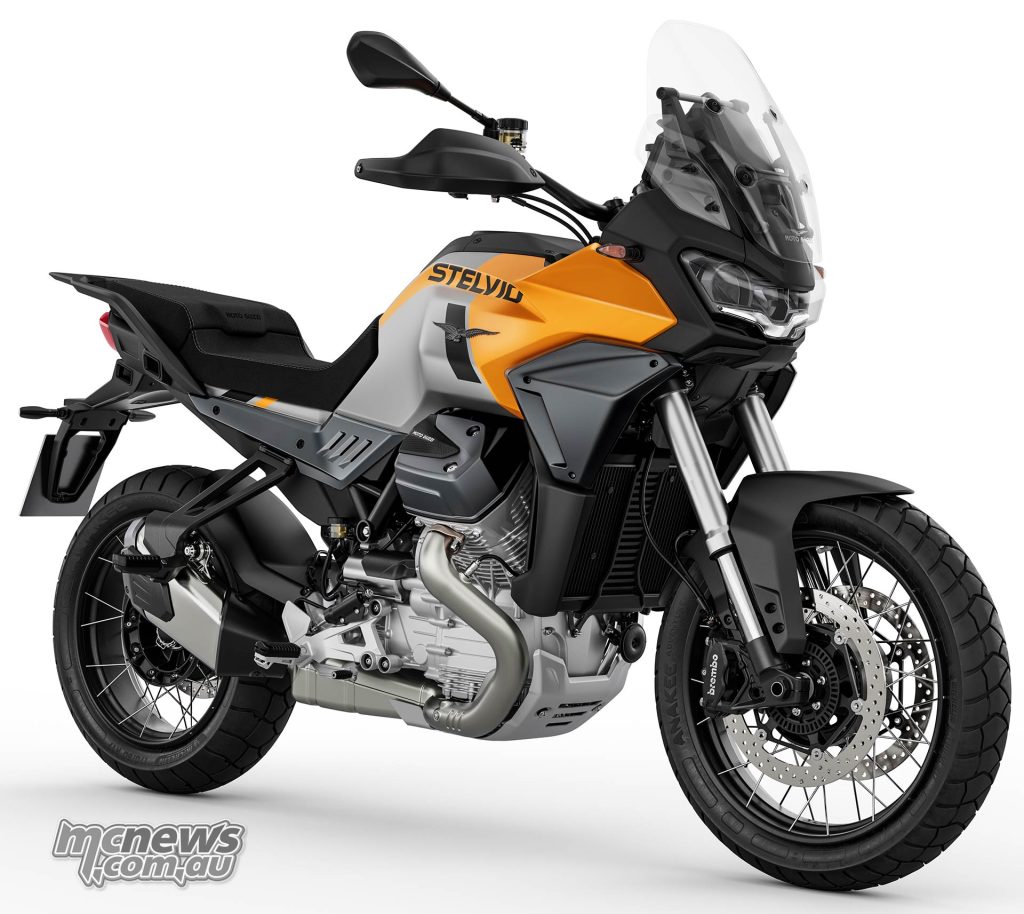
The luggage retention system does not require any additional supports, thus leaving the look of the bike uncluttered when not in use, saving weight and minimising lateral bulk. Just raise the passenger seat and insert the case hooks into the designated slots.
The 46 mm Sachs forks have 170 mm of travel and are adjustable for both rebound and spring pre-load, while the KYB shock absorber allows adjustments for rebound and spring preload via convenient adjusters.
The Brembo braking system incorporates a pair of 320-mm floating steel discs at the front, engaged by radial-mount monobloc callipers. The handlebar master cylinder, along with the clutch master cylinder, is also of a radial design, and both feature adjustable levers for distance to the handlebar.
A 280-mm disc is engaged by a dual-piston calliper at the rear. Tubeless spoked wheels, with a 19-inch front and 17-inch rear, accommodate tyres designed with a structure and tread pattern suitable for light off-road riding.
Stelvio is the first Moto Guzzi equipped with the PFF Rider Assistance Solution, offered as a factory option and built on 4D Imaging Radar technology and was developed by Piaggio Fast Forward, a robotics expert based in Boston, founded in 2015 by the Piaggio Group.
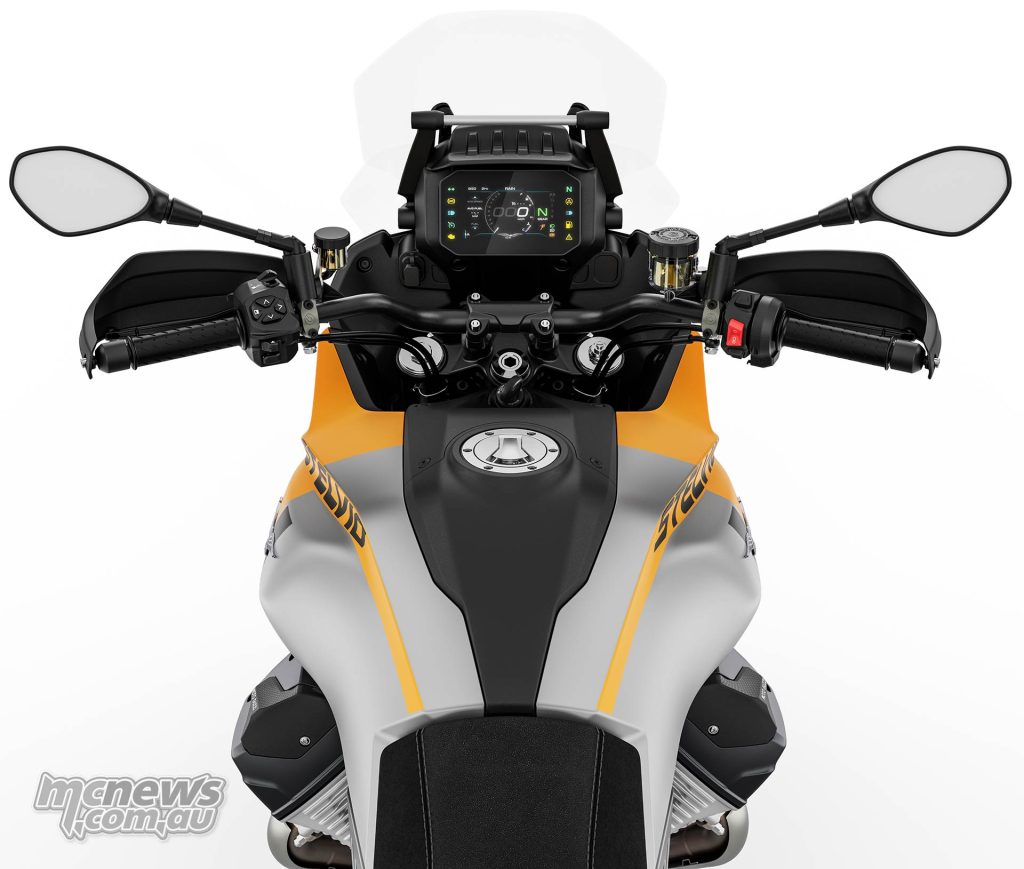
These devices play a key role on the active safety front, providing the Following Cruise Control (FCC), Forward Collision Warning (FCW), Blind Spot Information System (BLIS) and Lane Change Assist (LCA) functions. FCC represents an advanced cruise control system that utilises the front radar to adapt the speed based on the vehicle in front. This system intervenes in engine brake control, amplifying it if the vehicle in front decelerates.
An advanced Marelli 11MP control unit is informed by a six-axis IMU inform which allows the full potential of Cornering ABS, developed in collaboration with Continental.
There are five distinct Riding Modes available: Tourism, Rain, Street, Sport, and Off-Road. Each mode offers three different engine maps, four levels of traction control, three levels of engine brake and two levels of ABS control. Moto Guzzi’s technology is designed not only to enhance safety and enjoyment in riding but also to simplify life on the road. The rider simply needs to choose the Riding Mode that best aligns with their riding preferences to automatically achieve the optimal adjustment of the electronic parameters in use. These settings can also be personalised, allowing riders to fine-tune the parameters to match their individual preferences.
Standard equipment includes a full LED lighting system with Daytime Running Lights (DRLs), the ‘bending lights’ system (which adds extra headlamps in the windshields to illuminate the inside of corners, improving visibility when leaning), and a USB port located beside the instrumentation. The latter is a 5-inch colour TFT panel offering a range of information, such as fuel level, air and coolant temperature, gear engaged indicator, remaining range and instantaneous consumption.
Additional accessories include Moto Guzzi MIA, the multimedia platform enabling smartphone connectivity with the instrumentation through Bluetooth. Moto Guzzi MIA combines an infotainment system for managing voice assistant, phone calls, and music using intuitive handlebar controls, as well as a navigation feature. With this feature, after setting the destination on your smartphone, you can display directions directly on the instrumentation.
There are two colour variants, both matte: Giallo Savana, which features a dark yellow hue on the front of the tank and on the side panels, also available is Nero Vulcano, dominated by the black/grey combination, with some yellow highlights on the tank and side panels.
Australian delivery is expected to start in September, 2024, however pricing is yet to be confirmed.
2024 Moto Guzzi Stelvio Specifications
- Engine – 1042 cc, Liquid-cooled 90° transverse V-twin cylinder
- Bore x Stroke – 96 x 72 mm
- Compression Ratio – 12.6:1
- Claimed Power – 113 hp (84.6 kW) at 8700 rpm
- Claimed Torque – 105 Nm at 6750 rpm
- Valve Actuation – DOHC with finger rocker arms and four valves per cylinder
- Induction – EFI, dual 52 mm throttle boddies, ride-by-wire
- Fuel Capacity – 21 litres
- Gearbox – Six speed
- Clutch – Wet multi-disc clutch with slipper clutch and hydraulic control
- Frame – Tubular high-strength steel frame
- Front Suspension – Sachs telescopic hydraulic upside-down fork, Ø 46 mm, adj. pre-load and rebound. 170 mm travel
- Rear Suspension – Aluminium single-sided shock absorber left side, adj pre-load and rebound. 170 mm travel
- Front Brakes – Dual stainless steel floating discs, Ø 320 mm, Brembo radial-mount callipers with 4 opposed pistons and metal braided hose
- Rear Brake – Stainless steel disc, Ø 280 mm, Brembo floating 2-piston calliper.
- ABS – Continental ABS with cornering function
- Tyres – 120/70-19 (F); 170/60-17 (R)
- Length – 2195 mm
- Width – 945 mm
- Wheelbase – 1520 mm
- Seat Height – 830 mm
- Steering Angle – 25.6-degrees
- Trail – 116.4 mm
- Dry Weight – 222 kg
- Wet Weight – 246 kg with 90 per cent full tank
- Available – September, 2024
- RRP – TBC























